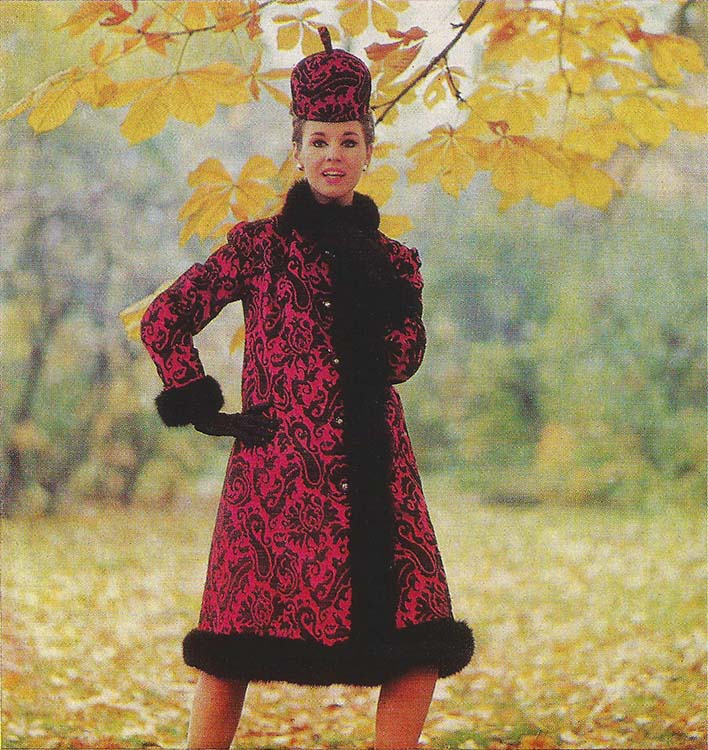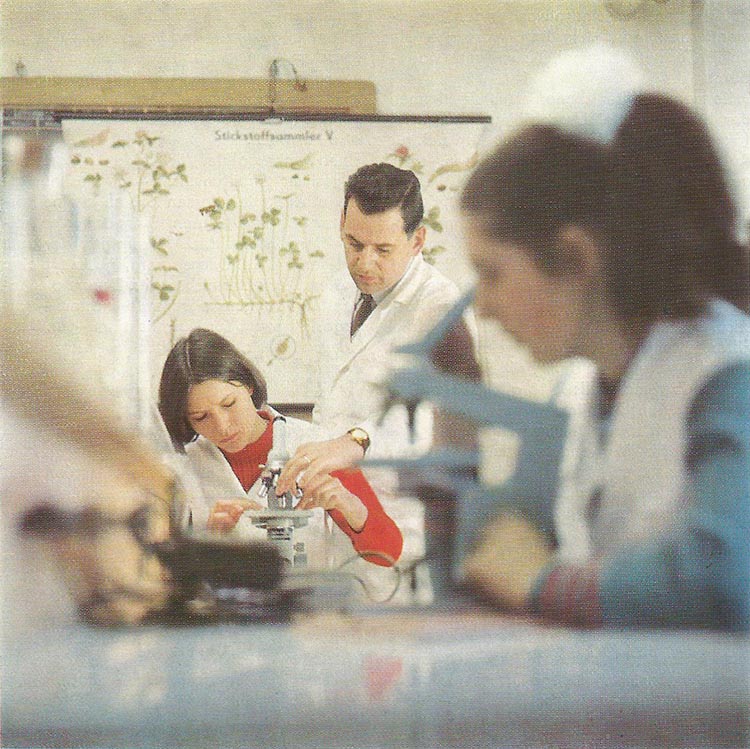by TRA
Format, Focal
Length & Focus
What are the advantages of larger-format cameras?
Elsewhere (here), I
have referred to higher image resolution. This
will be obvious, although as digital technology
develops, the gap between the best digital cameras and
medium format film cameras decreases.
| But
perhaps there is a more important answer.
One that cannot be overcome by advances in
technology: the shallower depth of field of lenses that are normally used on medium format cameras. This means a shallower in-focus zone within the image, with subjects that are nearer to the camera or farther away from it being increasingly fuzzy. |
You might say, “Who wants that?
Isn’t it better to have everything in sharp focus?”
The answer is, “Perhaps.” It depends on the type
of photography and the subject matter. For
instance, portrait
photography is one of the areas
where it is often desirable to limit the depth of field,
in order to direct the viewer’s attention to a
particular part of the image, usually the subject’s
eyes.
 This outdoor portrait, apparently for fashion advertising, would be spoilt if the background were in sharp focus. In “PENTACON six” Camera advertising brochure published by VEB Pentacon Dresden in 1967, p. 7 (Subject and photographer not named) |
|
 This image has been slightly cropped to give a vertical picture, as is suitable for many portraits. A sharp background would detract greatly from the impact of the picture. “Schauspielerin Heidemarie Wenzel” by Manfred Uhlenhut (Actress Heidemarie Wenzel) in “Pentaconsix Praxis” by W Gerhard Heyde, 1st edition, 1974, p. 95 |
| Unfortunately,
technical details of lenses and apertures used are
not given. I would suspect that the 80mm Biometar was used for the image on the left and the 120mm Biometar or the 180mm Sonnar for the image on the right, probably at or very near maximum aperture (f/2.8), regardless which lens was used. |
||
Of course, many people just want sharp
photos. They want everything
in the photo to be sharp.
But if we look at professionally-taken portraits, for
instance, we are likely to see that the background is
deliberately out of focus. In fact, on the
TV and in the cinema we may observe scenes of all sorts
where the focus moves backwards or forwards from one
thing that is in the frame to another – without changing
the composition.
To give a different example, if you see in a street a
tree with beautiful blossom on it, you may wish to take
a picture of it. But the picture would
probably be better if the building behind the tree
were more or less out of focus.
Depth of field
|
The zone of sharp focus is
usually called “depth of field”.
It doesn’t change with the size
of the film or the sensor. (However, as
the images from smaller film and sensor sizes
are frequently enlarged more for viewing than
the images from larger film/sensor sizes, it
can appear that the depth of field has
changed. In reality, all that has
happened is that any out-of-focus areas of the
image become more obvious if they are enlarged
more.)
Therefore, if the photographer
wishes to control the areas that are in focus
in his/her images,
In the image to the right, the very shallow zone of sharp focus has been carefully targeted on the subject, which is framed by out-of-focus components in front of it. The out-of-focus components are sufficiently recongnisable to give a context, while directing the viewer’s attention to the main subject, the young lady working with the microscope and her colleague or teacher. The out-of-focus components thus contribute to the image, instead of confusing the viewer as to what the subject is meant to be. |
|
 “Biologiestudenten” by Heinz Dargelis (Biology students) in “Pentaconsix Praxis” by W Gerhard Heyde, 1st edition, 1974, p. 133 |
For more examples of the deliberate use
of shallow depth of field, see here.
|
Advice
for viewing these pictures
As people browse the internet more and more on mobile phones, tablets, etc., it is important to point out that on such small screens it will probably be impossible to see the effect that is described here. A minimum recommended image size to appreciate the differential focus would be in the region of 5"×5" (approx 13cm×13cm), which is normally the minimum size of prints produced for images taken with 120 film. To appreciate the effect fully, I recommend viewing these images at 8"×8" (approx 20cm×20cm) or larger. Like all pictures taken with the Pentacon Six, the original negatives can be easily enlarged to sizes in excess of 2ft×2ft (approx 60cm×60cm) without any loss of detail or image quality. Naturally, to produce copies that can be downloaded from the internet within a reasonable period of time, I have had to reduce the resolution of these scans very substantially. |
The photographer can increase
the depth of field by using a smaller aperture on the
lens. But it is, by definition, not possible to reduce
the depth of field by using an aperture that is larger
than the maximum aperture of the lens!
Here are the standard focal lengths that are common for
various formats, plus the focal lengths that are
desirable for portraits with each of them:
|
Format |
Standard focal
length |
A good portrait
focal length |
|
Samsung S4 |
4.2mm (in 35mm: 31.0 mm) |
12-13.5mm (in 35mm: 90-100mm) |
|
110 film (approx 17 ×
13mm) |
24mm |
45-50mm |
|
APS-C format camera |
Approx 32mm |
57-64mm |
|
35mm camera |
50mm |
90-100mm |
|
6 × 6 medium format camera (54 × 54mm) |
80mm |
150-180mm |
|
4 × 5" (approx 127 × 102mm) |
150mm |
300mm |
As well as using lenses of longer focal lengths on cameras of the format for which they were intended, it is in theory also possible to use them on cameras of any smaller format, assuming that the smaller format camera permits the lens to be changed, and subject to the availability of a suitable adapter.
Example
The 110 format was introduced in 1972,
apparently with the aim of producing much smaller
cameras. The Pentax 110 was the only 110-format
camera that accepted interchangeable lenses. Its
standard lens had a focal length of 24mm.
Regardless what camera it is used on, a lens will always
project an image of the same size of whatever is before
it. The angle of view of the lens won’t
change. But – to give an extreme case – if a 150mm
lens, considered a standard focal length on a 5×4"
camera, is used on a 110 film format camera, the area of
view recorded on the film will be nowhere near the total
image projected by the lens. In fact, it will show
an area equivalent to what one would obtain if using a
300mm lens on a 35mm (“full frame”) camera. This
may be great for photographing distant wildlife, but it
will be no good for portrait photography, as you will
need a studio the size of an aircraft hangar in order to
get far enough away from your subject. And then
you will need a loud hailer or a telephone in order to
communicate with him or her!
However, the optical characteristics of the lens will
not have changed.
| Note that with digital
cameras, we must ignore the effect of
“digital zoom”, since this merely takes a
smaller section of the image and digitally
enlarges it to fill the frame. It
cannot change the optical characteristics
of the lens that the camera has. |
How can
we obtain that control over focus?
Depth of field is calculated by lens manufacturers on
the basis of a series of assumptions, including how much
they think that the image is likely to be
enlarged. The key idea is that they measure or
calculate the size of what they call a “circle of
confusion”, which is the size that a point or a dot is
reproduced if it is out of focus. (The more
out-of-focus it is, the larger it will appear to
be.) The in-focus zone of a lens of a given focal
length does not change with the format. However,
as smaller-format images may be enlarged more than
larger-format images, for practical purposes, different
sizes of circles of confusion are considered acceptable
for different formats. Smaller circles of
confusion are considered necessary for the smaller
formats.
Here is a summary of the depth of field for portrait
lenses on various formats, based on a camera-to-subject
distance of 2.5 meters, with the lens focussed at 2.5
metres and using the data calculated by http://www.dofmaster.com/dofjs.html.
Conversions from metric to imperial are rounded and are
taken from http://www.onlineconversion.com/length_common.htm.
|
Format |
Portrait focal
length |
Aperture |
Near limit |
Far limit |
Total depth of
field |
Approx Imperial equivalent |
|
4 × 5" |
300 mm |
f/4 |
2.48 m |
2.52 m |
0.05 m |
2" |
|
6 × 6 cm |
180 mm |
f/2.8 |
2.48 m |
2.52 m |
0.05 m |
2" |
|
35 mm |
90 mm |
f/2.8 |
2.44 m |
2.56 m |
0.13 m |
5" |
|
APS |
50 mm |
f/4 |
2.28 m |
2.77 m |
0.49 m |
19¼" |
|
50 mm |
f/5.6 |
2.2 m |
2.9 m |
0.71 m |
28" |
|
|
(mobile phone) |
12 mm |
f/2.8 |
1.13 m |
Infinity |
Infinite |
Infinite |
|
12 mm |
f/8 |
0.56 m |
Infinity |
Infinite |
Infinite |
|
|
4.3 mm |
f/2.8 |
0.24 m |
Infinity |
Infinite |
Infinite |
In fact, you are not likely to find a
mobile phone with a 12mm lens. It is likely to
have a lens of approximately 4.3 mm.
This shows us that with a portrait lens on a 4 × 5" or 6
× 6 cm camera, focussing at 2.5 metres and using the
lens at maximum aperture, we will have a sharp zone that
is just 2" or 5 cm deep. Of course, we can increase
the depth of that sharp zone by stopping down the lens
to a smaller aperture.
However, on an APS-format camera (which includes many
digital cameras) with a 50mm portrait lens at aperture
f/5.6, the depth the zone of sharp focus will be 28" or
71 cm.
A mobile phone will normally use face-recognition
technology in order to focus on that subject.
However, the area of sharpness when the lens is focussed
on a subject 2.5 m away will extend from 24 cm (about
9½") in front of the phone to infinity. In other
words, everything will be in
focus. For many subjects, we may want that, but
for others, it is undesirable.
With a mobile
phone, how can we reduce the area of sharpness
and control it?
We can’t.
- Not with a mobile phone.
- Not with the simplest digital cameras with their small sensors and lenses that only have a digital (not optical) zoom.
- Hardly at all with the majority of more sophisticated digital cameras with sensors that are more or less the APS size. Even if they have genuine optical zoom lenses. Even if they can accept other lenses.
As can be seen from above, a 50mm lens
operating at f/5.6 has a depth of field of nearly
three-quarters of a meter, nearly 2½ feet. That
is wider than the distance from one shoulder to the
other on the majority of adults. I
can’t see how it is possible with such a lens to limit
the depth of field, if desired, to the person’s eyes,
for instance. You may of course be able to move
the person away from the background, so that the
background is less sharp and more or less out of focus.
Being able to
control depth of field starts
with cameras that have a format of 35mm
(i.e., a film or sensor size of 24 × 36
mm, now commonly called “full frame”),
and even with them it only really
becomes noticeable if you meet three
criteria:
|
So for many people, controlling depth of
field only begins to be viable with medium format film
cameras, and it is surprising to observe from the above
table that on many occasions you can achieve the same
degree of control with a 6 × 6 cm camera to that which
is achievable with the much larger 4 × 5" (or 9 × 12 cm)
cameras. This is because the lenses for these
larger cameras generally have a smaller maximum
aperture.
And of course, as stated higher up, you can increase
the depth of field by using a smaller aperture.
However, if your imaging device has a lens with a very
short focal length and perhaps a not very large
aperture, there is nothing you can do to reduce
the depth of field.
For more on this subject, see the pages on this website
on
| In April 2017, I have now added examples of depth of field with the 80mm Biometar lens in macro photography. See them here. |
To choose other options, click below.
Home
© TRA First published: August 2016
Revised: November 2017